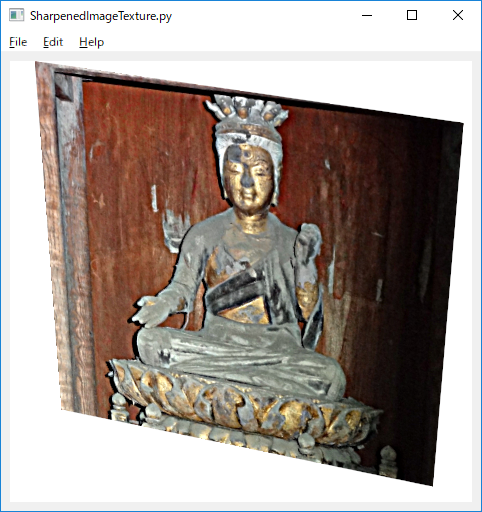|
SOL4Py Sample: SharpenedImageTexture
|

#******************************************************************************
#
# Copyright (c) 2018-2019 Antillia.com TOSHIYUKI ARAI. ALL RIGHTS RESERVED.
#
# This program is free software: you can redistribute it and/or modify
# it under the terms of the GNU General Public License as published by
# the Free Software Foundation, either version 3 of the License, or
# (at your option) any later version.
#
# This program is distributed in the hope that it will be useful,
# but WITHOUT ANY WARRANTY; without even the implied warranty of
# MERCHANTABILITY or FITNESS FOR A PARTICULAR PURPOSE. See the
# GNU General Public License for more details.
#
# You should have received a copy of the GNU General Public License
# along with this program. If not, see <http://www.gnu.org/licenses/>.
#
#******************************************************************************
# SharpendImageTexture.py
# encodig: utf-8
import sys
#
sys.path.append('../')
from SOL4Py.opengl.ZOpenGLMainView import *
from SOL4Py.opengl.ZOpenGLTexture2D import *
from SOL4Py.opengl.ZOpenGLImageInfo import *
from SOL4Py.opencv.ZOpenCVImageReader import *
from SOL4Py.opencv.ZOpenCVImageInfo import *
class MainView(ZOpenGLMainView):
##--------------------------------------------
class OpenGLView(ZOpenGLView):
def __init__(self, parent=None):
self.parent = parent
super(ZOpenGLView, self).__init__(parent)
self.angle = 120
self.texture = None
def initializeGL(self):
glEnable(GL_DEPTH_TEST);
glEnable(GL_TEXTURE_2D);
self.texture = ZOpenGLTexture2D();
reader = ZOpenCVImageReader();
filename = "../images/Figure.png";
image = reader.read(filename);
self.sharpend = self.sharpen(image);
self.texture.bind();
self.imageToTexture(self.sharpend)
self.texture.parameter(GL_TEXTURE_MIN_FILTER, GL_LINEAR);
self.texture.parameter(GL_TEXTURE_MAG_FILTER, GL_LINEAR);
self.texture.env(GL_TEXTURE_ENV_MODE, GL_MODULATE);
self.texture.unbind()
def sharpen(self, image): # originalImage = cv2.Mat
ksize = 21
sigma = 12
blurred = cv2.GaussianBlur(image, (ksize, ksize),
float(sigma), #sigmaX,
float(sigma), #sigmaY
cv2.BORDER_DEFAULT)
alpha = 2.5
beta = 1.0 - alpha
return cv2.addWeighted(image, alpha, blurred, beta, 0.0)
def imageToTexture(self, image):
cvImageInfo = ZOpenCVImageInfo()
imageInfo = cvImageInfo.getImageInfo(image);
self.texture.imageFromImageInfo(imageInfo);
def paintGL(self):
glClear(GL_COLOR_BUFFER_BIT | GL_DEPTH_BUFFER_BIT);
glClearColor(1.0, 1.0, 1.0, 1.0);
glMatrixMode(GL_MODELVIEW);
glLoadIdentity();
gluLookAt(2.0, 4.0, 6.0, 0., 0., 0., 0., 1., 0.);
#glRotate(30.0, 0.0, 0.0, 1.0);
self.texture.bind()
glBegin(GL_QUADS);
glTexCoord2f(0.0, 0.0)
glVertex(-1.0, 1.0, 0.0);
glTexCoord2f(1.0, 0.0)
glVertex( 1.0, 1.0, 0.0);
glTexCoord2f(1.0, 1.0)
glVertex( 1.0, -1.0, 0.0);
glTexCoord2f(0.0, 1.0)
glVertex(-1.0, -1.0, 0.0);
glEnd();
self.texture.bind()
glFlush()
def resizeGL(self, width, height):
if width == 0 or height == 0:
return
glViewport(0, 0, width, height)
glMatrixMode(GL_PROJECTION)
glLoadIdentity()
gluPerspective(16.0, width/height, 0.5, 100)
glMatrixMode(GL_MODELVIEW)
##--------------------------------------------
# MainView Constructor
def __init__(self, title, x, y, width, height):
super(ZOpenGLMainView, self).__init__(title, x, y, width, height)
# 1 Create first imageview.
self.opengl_view = self.OpenGLView(self)
# 2 Add the image view to a main_layout of this main view.
self.add(self.opengl_view)
self.show()
#*************************************************
#
if main(__name__):
try:
glutInit(sys.argv)
app_name = os.path.basename(sys.argv[0])
applet = QApplication(sys.argv)
main_view = MainView(app_name, 40, 40, 480, 480)
main_view.show ()
applet.exec_()
except:
traceback.print_exc()
Last modified:11 Apr. 2019
